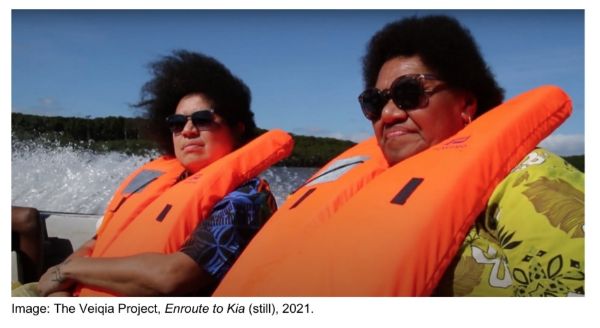ILakolako Ni Weniqia: A Veiqia Project Exhibition
Dr Tarisi Sorovi-Vunidilo, Margaret Aull, Donita Vatuinaruku Hulme, Joana Monolagi, Dulcie Stewart, and Luisa Tora

In 2018 members of The Veiqia Project travelled to Yaro Village on Kia Island in northern Fiji to spend time in talanoa with people there about the traditional Fijian female tattooing practice of veiqia.
Veiqia Project member Luisa Tora has committed the period of her Creative New Zealand / University of Canterbury Macmillan Brown Centre for Pacific Studies Artist Residency to editing a series of interviews filmed during the 2018 visit. Tora writes, “During these filmed interviews, village elders named their grandmothers and described seeing their weniqia. This corrects a historical oversight suffered by Fijian women who were rarely identified in colonial records. We were also privileged to visit the Village qara ni veiqia (cave where Yaro women and girls received their weniqia).” The film sits alongside research material and three matakau, female ancestral figures carved by collective member Maragaret Aull, who writes, “Matakau are part of our material culture that can give an insight to our past, with many carved or having ink traces of weniqia applied.” The gallery will also be the site of a panel discussion including members of the collective.
The Veiqia Project is a collective of artists, curators, researchers, and academics based in Australia, Hawai’i, and Aotearoa New Zealand: Dr Tarisi Sorovi-Vunidilo, Margaret Aull, Donita Vatuinaruku Hulme, Joana Monolagi, Dulcie Stewart, and Luisa Tora. Curator Ioana Gordon-Smith, who worked with The Veiqia Project on the exhibition names held in our mouths (2019) at Te Uru Gallery, writes “Working primarily outside of formal institutions, these modes of revival and transmission, which range from transnational exchanges, museum studies, and close reading of texts, often depend upon and result in a collective impulse. They also expose a number of oscillating concerns, such as the twin needs of protectionism and open sharing; revival and adaptation; local and global influences.”
The collective’s work continues despite the practice having been deeply impacted by colonisation, capitalism, and migration. At the heart of this is a commitment to sharing their findings with a wide community, within which iTaukei (indigenous Fijian) women are primary. Dr. Karen Jacobs, author of This is not a grass skirt (2019), has noted, “Liku and veiqia were closely related to their female wearers, yet became alienated in museums where they were translated, classified and sometimes further exchanged. Separated from their original context they are potential connectors that have the ability to cross temporal and spatial separators and can express different ontologies (Tapsell 1997; Mahina 2010; Ka’ili 2005).” It is this capacity to connect, to cross space and time that separate, that gives purpose to the exhibition, and the project as a whole. In the years since The Veiqia Project’s 2018 visit to Kia, and including sending relief packages following Cyclone Yasa and a book donation in collaboration with Vunilagi Book Club, this collaboration continues to involve the women of Kia and their families.
____________
Luisa Keteiyau Tora (Kadavu) is an interdisciplinary artist who focusses on indigenous, queer, and feminist themes. She lives in Ōtāhuhu.
The Veiqia Project is a creative research project inspired by the practice of Fijian female tattooing of veiqia. Five contemporary Fijian women artists based in Aotearoa New Zealand, Australia, and Hawaii collectively research veiqia to inform the development of new artwork. Past exhibitions include The Veiqia Project, ST PAUL St Gallery, Tāmaki Makaurau (2016); The Veiqia Project, (Margaret Aull, Selai Buasala, Mereula Buliruarua, Elizabeth Edwards, Donita Donita Vatuinaruku Hulme, Katarina Lesumai, Joana Monolagi, Dulcie Stewart, Laurel Stewart, Luisa Tora and VOU Dance Fiji artists, Mere Rosi Navuda, Elizabeth Tanya Sidal, Bernadette Kaulotu Suiqa, Koleta Dravuni Tobeyaweni, and Ta’Arei Weeks), Fiji Museum, Suva (2017); names held in our mouths (alongside Sosefina Andy, Nikau Hindin, Louisa Humphry, Wikuki Kingi, Pacifica Mamas and Kaetaeta Watson), Te Uru Waitākere Contemporary Gallery, Tāmaki Makaurau (2019); Marama Dina (Margaret Aull, Torika Bolatagici, Donita Vatuinaruku Hulme, Yasbelle Kerkow, Joana Monolagi, Dulcie Stewart, Salote Tawale, Luisa Tora, MC Trey aka Thelma Thomas, and Emele Ugavule), Campbelltown Arts Centre, Campbelltown, New South Wales (2019).
____________
This exhibition is a result of the ongoing partnership between The Physics Room and the University of Canterbury Macmillan Brown Centre for Pacific Studies to present work and research produced during the residency.
We would like to thank Pixel for their generous support of this exhibition.
____________
For more information, visit www.physicsroom.org.nz


 Whanganui Regional Museum: Historic Wedding Dress Unveiled, A Piece Of Marton’s Heritage
Whanganui Regional Museum: Historic Wedding Dress Unveiled, A Piece Of Marton’s Heritage Donovan Ryan: Local Runner Takes Out Frontrunner Christchurch Marathon
Donovan Ryan: Local Runner Takes Out Frontrunner Christchurch Marathon University of Auckland: Tributes Flow For Much Loved Pacific Leader Melegalenu’u Ah Sam
University of Auckland: Tributes Flow For Much Loved Pacific Leader Melegalenu’u Ah Sam NZEI: Ministry Of Education Cuts Will Disproportionately Affect Pasifika
NZEI: Ministry Of Education Cuts Will Disproportionately Affect Pasifika Day One Hapai te Haeata: Call To Action For Young Filmmakers Against The Backdrop Of Funding Cuts
Day One Hapai te Haeata: Call To Action For Young Filmmakers Against The Backdrop Of Funding Cuts Toyota New Zealand: Three Races For Top Three To Decide TR86 Title
Toyota New Zealand: Three Races For Top Three To Decide TR86 Title